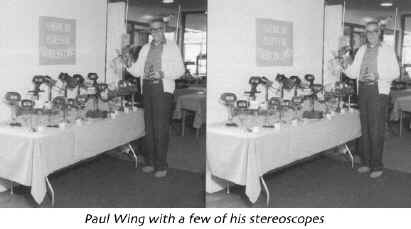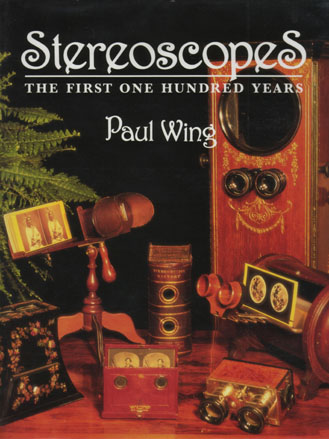It’s been a tough year for stereography. Within the past year we’ve lost several important long-time stereographers. Charles Piper, author of the “The Technical Page” for the 3D News of the Stereo Club of Southern California (SCSC), left us late in 2001. George Skelley, veteran stereo photographer and maker of stereo mounts as well as a NSA, SCSC and ISU member followed shortly after Charlie. Then Earl Colgan, a beloved and very active international stereo photographer, passed away 2 weeks prior to his 98th birthday in February 2002.
Now, Paul Wing, a true giant in the field of stereography has shuffled off the standard mortal interocular for hyperstereo glories elsewhere. Paul passed away on March 7, two days before his 89th birthday. The importance of Paul Wing in contemporary stereography cannot be overstated. Paul was a veteran of more than a half century of stereoscopy and was one of only four Lifetime Members in the Stereoscopic Society of America (SSA). Member number 385 in the SSA, Paul was an internationally recognized master stereographer and the author of “Stereoscopes: The First One Hundred Years,” (Transition Publishing: 1996), the definitive history on the subject and one which will undoubtedly remain so for a long time to come. In 1997 Paul graciously inscribed a copy of his book for me: “To Ray Zone, 3-D Enthusiast!”

“If 3-D is involved, I am interested,” wrote Paul in the 1999-Year Book of the SSA. “As a photographer I have enjoyed making pairs with other than normal eye spacing from close up (birds and flowers) to miles away (aerial hypers).” Despite six decades of experience in stereography Paul was never limited in his approach. In a recent SSA folio I sent around a stereocard that was a “blinker,” in which 2-step animation could be created by alternately closing and opening the left and right eyes. Some stereographers might consider this a radical or inappropriate use of the medium. But Paul enthusiastically responded by sending in the next folio historical notes and a blinker that had been created in 1870.
Paul was first intrigued with stereocards in the early 1920s and by the time he finished high school during the Great Depression he was making “cha cha,” stereo photographs using side-step with a [2D] Kodak Brownie camera. In the 1940s, Paul met Dr. Philip Batchelder, a stereo collector and a member of the American Branch of the Stereoscopic Society of Great Britain. “It opened a New World,” Paul wrote in the foreword to his book on stereoscopes. “After a visit to his home, I couldn’t sleep all night. His collection of [stereo] views and viewers, neatly presented in a special room, overwhelmed me.”
As a collector of stereographic views, viewers and cameras, a stereo historian and a practicing stereo photographer, Paul was unique. When it came to 3-D, Paul did it all. A few years ago, along with Ron Labbe and Dan Gosch, Paul exhibited his stereo photography at an art gallery in Boston. I remember a great stereo slide-show on Old China that Paul presented at the NSA Convention in San Diego in 1997. The images were copied in a pristine manner from old stereoviews and Paul’s commentary was a delight.
I first contacted Paul in 1987 at the suggestion of Susan Pinsky. Paul graciously lent me dupes of French tissue “Diableries’ which I printed in a comic book called “3-D Danse Macabre.” Paul has written several definitive articles on the subject in the pages of Stereo World. Paul has also unfailingly assisted me with research into the history of stereodrawing. His fund of historical information on stereography was practically limitless.
Most recently, I was delighted when Paul joined the SSA Speedy Alpha I and II folios where everybody benefited from the views Paul enclosed as well as his informed and funny comments on their work. Some of the views Paul sent around were stereocards of his children that he had made in the 1940s! Of course, they were very well executed and composed.
The Speedy folios are limited to only 12 participants so the views make a rather quick circuit. I treasure the stereo view sleeves on which Paul has inscribed his comments about my views in a rather spidery hand. “There are a number of things I could say,” wrote Paul regarding a hyperstereo card with wide separation I sent around in 1999. “I free vision pairs with even wider separation, but I think butting two 3 1/2″ squares together is going too far!”
For another radical hyperstereo card I had sent, Paul actually made a corrected version of the card and enclosed it in the sleeve. “I marvel that none of you mentioned having a bit of trouble viewing this,” he observed. But Paul’s comments were always instructive and encouraging. “I look to your envelope for something really different,” he wrote most recently.
We all looked to Paul Wing for something really different. He was a stereographic fount of invention and history. He will be more than missed. He is irreplaceable in the pantheon of stereography. As I write, it’s very likely that Paul is now setting up a stereo photograph (in some radiant new medium). And he is undoubtedly creating a stereo base that is measurable in light years, parsecs instead of inches.
